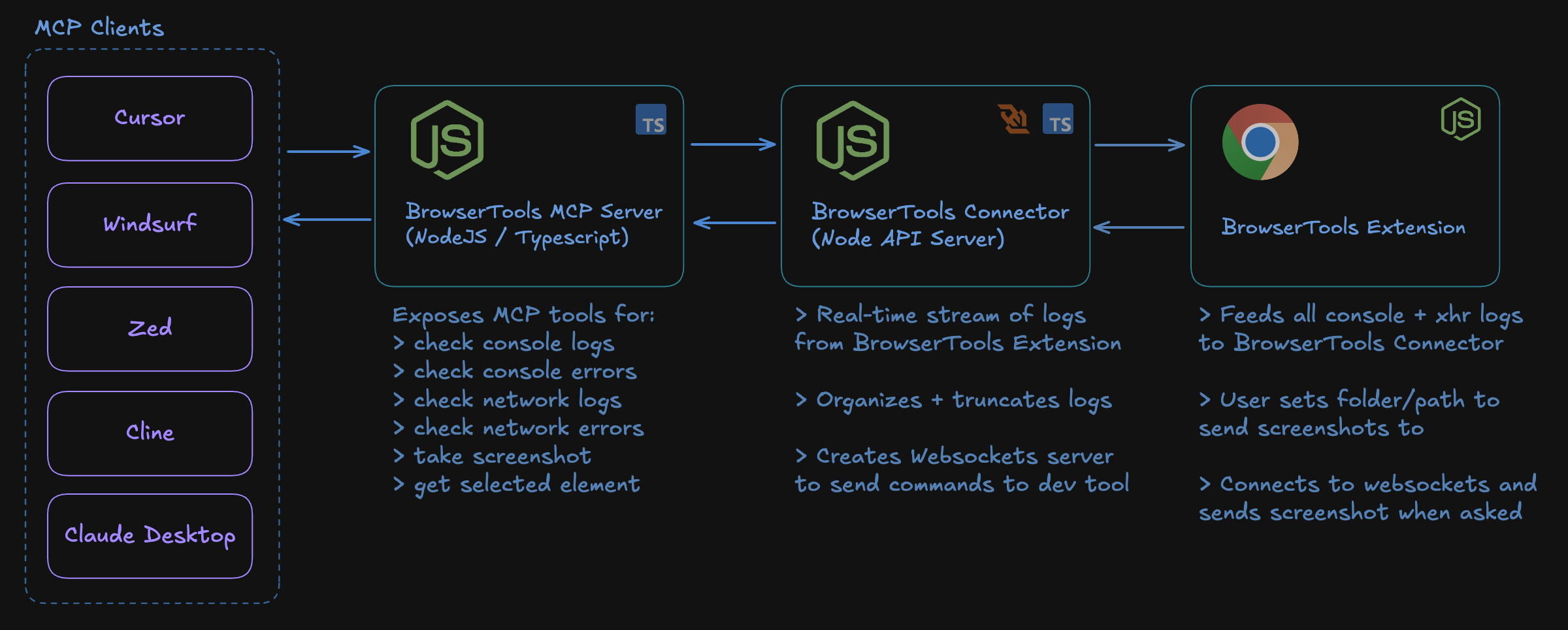Architecture
There are three core components all used to capture and analyze browser data:- Chrome Extension: A browser extension that captures screenshots, console logs, network activity and DOM elements.
- Node Server: An intermediary server that facilitates communication between the Chrome extension and any instance of an MCP server.
- MCP Server: A Model Context Protocol server that provides standardized tools for AI clients to interact with the browser.

Chrome Extension
- Monitors XHR requests/responses and console logs
- Tracks selected DOM elements
- Sends all logs and current element to the BrowserKit Connector
- Connects to Websocket server to capture/send screenshots
- Allows user to configure token/truncation limits + screenshot folder path
Node Server
- Acts as middleware between the Chrome extension and MCP server
- Receives logs and currently selected element from Chrome extension
- Processes requests from MCP server to capture logs, screenshot or current element
- Sends Websocket command to the Chrome extension for capturing a screenshot
- Intelligently truncates strings and # of duplicate objects in logs to avoid token limits
- Removes cookies and sensitive headers to avoid sending to LLMs in MCP clients
MCP Server
- Implements the Model Context Protocol
- Provides standardized tools for AI clients
- Compatible with various MCP clients (Cursor, Cline, Zed, Claude Desktop, etc.)
Future Enhancements
If you’re willing to take a stab at these ideas, go for it! Would appreciate any and all help 🙏- Add unit tests
- Integrate Stagehands for natural language dom traversal
- Integrate BrowserUse for automated feature testing
Contributing to BrowserTools MCP
Thank you for your interest in contributing to BrowserToolsMCP! We welcome contributions from the community and appreciate your help in making this project better.How to Contribute
There are many ways to contribute:- Bug Reports: Help us improve the project by reporting issues or bugs.
- Feature Requests: Suggest new features or improvements.
- Code Contributions: Submit bug fixes, enhancements, or new features via pull requests.
- Documentation: Improve the documentation or add new guides.
- Testing: Help test new releases and report issues.
Getting Started
- Fork the Repository: Click the Fork button on the top right of the repository page.
- Clone Your Fork
-
Create a Branch:
Create a new branch for your work. Use a descriptive name: -
Make Your Changes:
Write your code or documentation changes. -
Commit Your Changes:
Write clear commit messages. If your change fixes an issue, include the issue number (e.g.,Fixes #42): -
Push to Your Fork:
-
Open a Pull Request:
Navigate to the original repository and click on New Pull Request. Fill in the template provided and describe your changes.
Reporting Issues
Before reporting a new issue, please check the issue tracker to see if it has already been reported. When reporting a bug or suggesting a feature, please include:- A clear description of the issue.
- Steps to reproduce (for bugs).
- Expected and actual behavior.
- Screenshots, logs, or any other details that can help us understand the problem.
Coding Guidelines
- Write clear and descriptive commit messages.
- Ensure your code is well-commented and follows best practices.
- Include tests for your code changes where applicable.
Documentation
- Update the documentation with your changes if necessary.
- Ensure that new features and improvements are reflected in the README or separate documentation files.
- Consider adding examples or code snippets to help users understand how to use new features.
Getting Help
If you have any questions or need assistance:- Open an issue on GitHub.
- Read out to @tedx_ai (DMs should be open)

